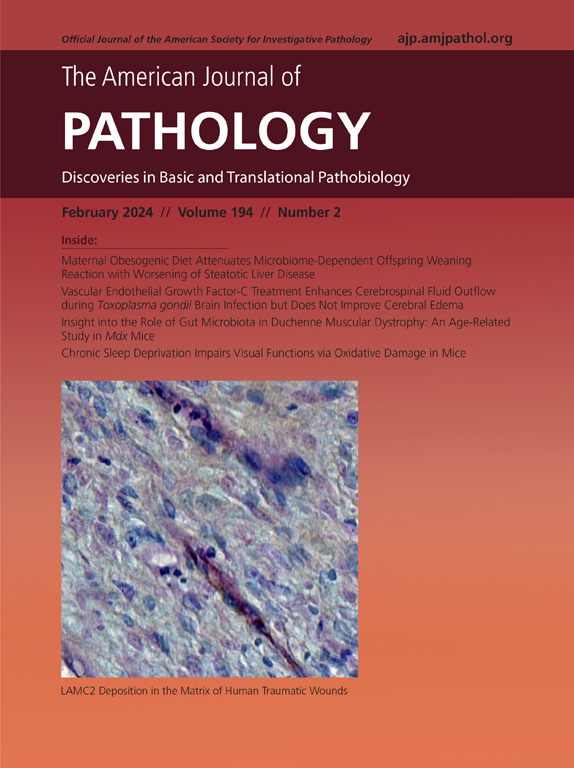The Long Noncoding RNA TUG1 Is Down-Regulated in Osteonecrosis of the Femoral Head and Enhances the Osteogenic Differentiation of Bone Marrow Mesenchymal Stem Cells by Stimulating the Wnt/β-Catenin Pathway
IF 3.6
2区 医学
Q1 PATHOLOGY
引用次数: 0
Abstract
Osteonecrosis of the femoral head (ONFH) is an orthopaedic disease with multifaceted pathogenesis. The role of long noncoding RNA (lncRNA) taurine-up-regulated gene 1 (TUG1) in ONFH remains unexplored. Thus, lncRNA expression profiles in subchondral bone from patients with ONFH and healthy controls were analyzed using microarray analysis, RT-qPCR, and bioinformatics. To evaluate the effect of TUG1 on osteogenic differentiation, TUG1 was overexpressed or knocked down in human bone marrow mesenchymal stem cells (hBMSCs), assessed via quantitative RT-PCR, Western blot analysis, and staining assays. In vivo, TUG1 was knocked down using adeno-associated viruses in a rat ONFH model. Micro–computed tomography, histology, enzyme-linked immunosorbent assay, quantitative RT-PCR, and immunohistochemistry were used to assess bone mass and osteogenic markers. TUG1 was significantly down-regulated in ONFH subchondral bone. Overexpression of TUG1 in hBMSCs up-regulated osteogenesis-related genes and proteins (runt-related transcription factor 2, osteopontin, osteocalcin, collagen type I alpha 1 chain, bone morphogenetic protein 2, and β-catenin), enhanced alkaline phosphatase activity, and increased mineralization. Conversely, TUG1 knockdown reduced these markers. In vivo, TUG1 knockdown disrupted bone microstructure and decreased osteogenic marker expression in the femoral head. This study revealed that TUG1 is down-regulated in ONFH subchondral bone, leading to osteogenic dysfunction through the Wnt/β-catenin pathway. It provided a better understanding of lncRNA's regulatory role in local osteonecrosis and offered new insights into ONFH pathogenesis. This study provides a reference for future research and treatment strategies.
长链非编码RNA TUG1在股骨头坏死中下调并通过刺激Wnt/β-Catenin通路促进骨髓间充质干细胞成骨分化
股骨头坏死(ONFH)是一种具有多方面发病机制的骨科疾病。长链非编码RNA (lncRNA)牛磺酸上调基因1 (TUG1)在ONFH中的作用尚不清楚。因此,使用微阵列分析、RT-qPCR和生物信息学分析了ONFH患者和健康对照者软骨下骨中的lncRNA表达谱。为了评估TUG1对成骨分化的影响,我们在人骨髓间充质干细胞(hBMSCs)中过度表达或敲低TUG1,通过定量RT-PCR、Western blot分析和染色试验进行评估。在体内,使用腺相关病毒在大鼠ONFH模型中敲除TUG1。显微计算机断层扫描、组织学、酶联免疫吸附测定、定量RT-PCR和免疫组织化学用于评估骨量和成骨标志物。TUG1在ONFH软骨下骨中显著下调。TUG1在hBMSCs中过表达上调成骨相关基因和蛋白(侏儒相关转录因子2、骨桥蛋白、骨钙素、I型胶原α 1链、骨形态发生蛋白2和β-连环蛋白),增强碱性磷酸酶活性,增加矿化。相反,TUG1敲除减少了这些标记。在体内,TUG1敲低破坏了股骨头的骨微观结构,降低了成骨标志物的表达。本研究发现,TUG1在ONFH软骨下骨中下调,通过Wnt/β-catenin通路导致成骨功能障碍。这为lncRNA在局部骨坏死中的调控作用提供了更好的理解,并为ONFH的发病机制提供了新的见解。本研究为今后的研究和治疗策略提供参考。
本文章由计算机程序翻译,如有差异,请以英文原文为准。
求助全文
约1分钟内获得全文
求助全文
来源期刊
CiteScore
11.40
自引率
0.00%
发文量
178
审稿时长
30 days
期刊介绍:
The American Journal of Pathology, official journal of the American Society for Investigative Pathology, published by Elsevier, Inc., seeks high-quality original research reports, reviews, and commentaries related to the molecular and cellular basis of disease. The editors will consider basic, translational, and clinical investigations that directly address mechanisms of pathogenesis or provide a foundation for future mechanistic inquiries. Examples of such foundational investigations include data mining, identification of biomarkers, molecular pathology, and discovery research. Foundational studies that incorporate deep learning and artificial intelligence are also welcome. High priority is given to studies of human disease and relevant experimental models using molecular, cellular, and organismal approaches.

 求助内容:
求助内容: 应助结果提醒方式:
应助结果提醒方式:


